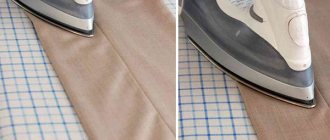A sweater is a universal and all-season clothing. For cold winters, choose models knitted from thicker yarn; for warmer seasons, knitwear or acrylic. But over time, any product develops one unpleasant feature - the elastic bands at the bottom and on the cuffs stretch.
And although the sweater still allows you to keep warm, it doesn’t look at all the way you would like. You shouldn’t rush things and classify your favorite thing as out of use: it can still be fixed. How? Read about it below.
@nashsovetik.ru
A stretched elastic band on a sweater is not a death sentence
Before you begin resuscitation, it is important to understand why the elastic band became deformed. This can be blamed on:
- Quality and properties of yarn. If the sweater was knitted from low-grade threads, then you should not even think about the reason why the elastic bands stretched - it is obvious. It’s a completely different matter when the yarn is of high quality, but is not elastic, or, on the contrary, is prone to changing shape. Then it all depends on how often and how carefully the item was worn and washed.
- Incorrect care. Everyone knows that sweaters made from natural yarn require delicate cleaning and the use of special products. Otherwise, the item will become deformed after the first wash.
- Frequent wear. Don't be surprised that your favorite sweater, which you literally never take off, will eventually turn into a shapeless hoodie. Intensive use leads to the fact that the wear time is significantly reduced.
In addition, it is worth noting the habit of many people to pull the bottom and sleeves of their sweaters as low as possible. By constantly tugging on the elastic bands, you should not hope that they will remain strong and elastic for a long time.
Why do things get deformed?
A sweater and outer jacket are those wardrobe elements that are made from fairly elastic materials; synthetics are often mixed into the fabrics. This is why they can stretch out after washing, increase or decrease in size, and the edges can become uneven. Also, undoubtedly, too much frequent wear has a negative effect on the original condition of the product - it can not only expand the sleeves, but also change the length of the item. After such deformation, the clothes look ugly, they may not fit correctly, and there is no desire to wear them. Your only option is to try to pull the jacket back.
What if only part of the sweater lost its shape?
It happens that only part of the sweater has lost its shape, for example, the sleeves have stretched or the neck has become shapeless. What to do in such a situation? There is no need to wash the item completely. Use a spray bottle to spray hot water on the stretched area or submerge the area in hot water. Then spread the jacket on a towel placed on a hard, flat surface and shape it into the desired shape by gently moving the fibers with your palms towards each other.
How to “pull” the elastic on a sweater
Due to the fact that the elastic band of the sweater neck is narrower than the head, and the cuffs are narrower than the hands, they tend to stretch over time. To remove shapelessness, wet the elastic with water, lay the jumper on the floor and move the threads towards the middle. For greater effect, you can use needles or pins. Pin the elastic in several places with them and leave until the item is completely dry.
How to prevent clothes from stretching?
Your main “savior” in such a situation is cold water. Fill a basin with cold water, wet the item, then gently squeeze out excess moisture. Twisting or other aggressive mechanical actions can damage knitted fibers.
Interesting materials:
How are horizontal blinds fixed? How to format a prestige tablet? How to shape a young pear? How to shape juniper? How is profit before tax formed? How is the organization's accounting policy formed? How to tell fortunes about your betrothed before going to bed? How to iron eco-leather? How to iron nylon curtains? How to iron a coat made of polyester and wool?
DIY shrinking methods
Let's consider several basic ways to restore elasticity to the threads and compress them to their original state:
- re-wash;
- give the desired shape;
- dry.
It would seem that everything is simple, but there are small tricks that will help restore the product to its former appearance.
We erase “correctly”
To restore the threads, you need to wash the sweater. If you prefer to machine wash, follow the instructions:
- Place the sweater in a special laundry bag and place it in the machine drum.
- Add liquid detergent intended for washing woolen items to the powder compartment. This liquid laundry detergent is sold at any hardware store.
- Set your machine to the accelerated wash cycle. The temperature should be at least 90 degrees.
- Turn off the spin function. It can be replaced by draining water.
- After the machine has done its job, remove the sweater from the bag and wring it out with your hands.
The key is hot water, which will shrink the fibers back to their original state.
Another good way is to alternate the water temperature. Place the jumper in boiling water for 3-4 minutes, then transfer it to a bowl of cold water. Do this maneuver several times. Due to the sudden change in temperature, the wool threads will tighten.
Drying “correctly”
After washing, stretched items should be dried in a horizontal position. To do this, you will need a large towel or thick fabric that absorbs water well. Lay out the sweater on a spread towel and start tidying it up. Gently pull the sleeves horizontally and vertically. Pull in the neckline and waist. Use your palms to move the fibers around each other throughout the product. Now you are a sculptor who cuts off everything unnecessary, giving the product the desired shape.
Make sure that the towel on which you dry the item is not too wet. It is advisable to change it several times so that the sweater does not absorb the smell of moldy dampness. You can dry a sweater only naturally, without resorting to a battery, hair dryer, steam generator or sunlight. Too much heat can cause the threads to become distorted.
Using a towel
The main reason for wool and synthetic fibers to stretch is strong spinning and twisting after washing. The drum of a washing machine, spinning up to several thousand revolutions, can stretch a jumper into several sizes. Therefore, spinning in the machine is prohibited. Some manufacturers indicate this rule on labels sewn to clothing.
Squeezing wool by hand can also damage the fibers and greatly stretch the threads. An acceptable method is to squeeze out water using a terry towel. Carefully wrap the jumper in a towel and leave it for 3-4 minutes. If water continues to drip from the sweater, use a new, dry towel. After excess moisture has been absorbed, the product can be dried.
We use boiling water
Another good way to return a wool or cashmere sweater to its original size is to soak it in boiling water. Fill a basin with water at a temperature of at least 80 degrees and lower the sweater into it. Leave for 10-15 minutes. If the room in which you wash is too cold and the water cools quickly, repeat the procedure several times. To make the threads elastic, you can add 1 tablespoon of apple cider vinegar or 50 ml of softening fabric conditioner to the water. After soaking, you can start washing.
There is no need to stretch the jumper while washing; carefully lift it and lower it into the water. Do not “pinch” the product or rub it too hard.
Do not use a brush to remove stains; it will damage the threads.
Partial restoration
If after washing, drying or wearing only a certain area of the sweater has lost its shape, then you can use the following method:
- wet the damaged fabric of the item with a water spray;
- carefully lay the sweater on a towel or terry cloth;
- give the lost area its previous shape;
- After a few hours, the sweater will acquire a uniform structure and a suitable size.
A hairdryer will help speed up the drying process. But only cold air flow is allowed for this. Hot jets can only damage the fabric and make it unusable.
Remove and change the rubber band
This is a troublesome, but at the same time effective method. In addition, there is no need to expose the fabric of clothing to iron or water. In this case, we use the following sequence of actions:
- Turn the garment inside out and make a small cut on one side in the hem of the garment where the ribbon is located. It is enough to make a hole of one and a half centimeters. If the tape is sewn into a seam, the latter will have to be ripped out. This is easy to do with scissors;
- Carefully cut the elastic in one place and carefully remove it from the hole. Pull it out slowly and do not lose the tape in the folds of the fabric. If the item fits the figure normally and without elastic, you can sew up the hole or hem it and leave it like that;
- If without an elastic band the clothes look unsightly or do not hold, we can lengthen the ribbon by sewing a piece of the required length, or insert another elastic thread that is more comfortable and suitable in size;
- We carefully insert the tape back into the hem and distribute it evenly using a safety pin. Before sewing the seam, try on the product to see if it is too tight for you.
Please note that it may not be just the tight tape. Clothes in general may be too small. In this case, you need to stretch the fabric completely. Stretching methods depend on the type of material. For some, boiling water and an iron are suitable, for others - steaming. In some cases, it is enough to pull the item onto a chair or ironing board. For example, wool stretches well. And how to stretch a cotton item, read the link https://vsepodomu.ru/garderob/kak-rastyanut-khlopkovuyu-vesch/
How can you stretch the elastic on shorts? The shorts themselves stretch well, but the elastic is tight. Moreover, it is sewn in and cannot be pulled out because... it's like it's part of the shorts themselves. Stretching on the back of a chair for 24 hours did not help. Any ideas?
Cut and sew in a piece of another elastic band or just fabric.
In such cases, I do this: I rip out the sewn elastic near the side seams. Where it is usually blocked by hands. If it is sewn with a double stitch, you will have to rip both the top and the bottom. I rip the threads about 1.5 cm apart. Then I carefully cut this elastic both on the right and on the left. Immediately you will get an increase in waist volume by 2-3 cm. Then I carefully sew these places by hand. If this is not enough, then you can embroider and cut the elastic a little more. And if this is not enough, then the same operation can be performed near the back seam on the back.
Cut and sew in a piece of another elastic band or just fabric.
New features and design have appeared for the version of the Woman.ru Forum on computers. Tell us, what are your impressions of the changes?
In such cases, I do this: I rip out the sewn elastic near the side seams. Where it is usually blocked by hands. If it is sewn with a double stitch, you will have to rip both the top and the bottom. I rip the threads about 1.5 cm apart. Then I carefully cut this elastic both on the right and on the left. Immediately you will get an increase in waist volume by 2-3 cm. Then I carefully sew these places by hand. If this is not enough, then you can embroider and cut the elastic a little more. And if this is not enough, then the same operation can be performed near the back seam on the back.
Reducing individual elements
If the elastic band on a sweater has stretched, i.e. not the entire product, but its separate part (sleeves, neckline), then it can be restored separately without subjecting the entire fabric to water procedures. The jacket should be laid out on a flat horizontal surface. Use a spray bottle to moisten problem areas. When the fabric gets wet, it should be pulled so that the threads move in the opposite direction from the stretch. You can secure this position with a pin or rubber band. The sweater is left in this position until completely dry.
If the cuffs or other parts of the product have not stretched much, after moving the threads to the center, you can speed up the process of removing excess moisture. You can dry the sweater using an iron. To avoid damaging the fabric, it is recommended to iron the product through a piece of gauze folded several times. You can use a terry towel, but with each new ironing you should cover the jacket with the dry side.
Another method that cannot always be used to make a sweater smaller; in most cases, it is suitable for those products that were independently knitted. You can unravel the stretched part and then bandage it. To avoid having to unravel the entire sleeve if only the cuff is stretched, it is recommended to give preference to a needlework style that involves knitting from the elbow to the hand. There are fewer problems with the neck. In most cases, it is knitted separately from the body of the sweater and then sewn on.
What should you do if the elastic band on your sweater or the cuffs on the sleeves are stretched?
It is not always necessary to throw away an item if it has lost its shape. Deformation can be reduced if the clothes are made of wool, cashmere, or if these materials predominate in the composition. There are several ways to restore a product's attractive appearance.
Machine method
You can reduce stretched elastic by washing it in the machine again. You need to take the product, put it in a special bag, turn on the appropriate mode, for example, “Wool” or “Delicate wash. Detergents also need appropriate ones - those that are designed for washing things that are prone to stretching. After finishing the program, the clothes should be carefully wrung out by hand, but not twisted, and laid out on a terry towel, pushing each seam closer to each other.
For knitwear, it is recommended to choose a temperature of 60 degrees, and in the case of colored clothes, the temperature should be even lower, otherwise it will fade. After such manipulations, a high-quality, correctly sewn item will return to its shape (if a sweater or jacket has uneven seams, it will be more difficult to reduce the stretched elastic band).
Manual method
If the item cannot be washed by machine, you can try restoring it manually. The item is soaked in water at a temperature 15-20 degrees higher than indicated on the tag for half an hour and washed using detergents. Next, it is transferred to a container with ice water, rinsed, gently squeezed, and the excess water is soaked with a terry towel.
The subsequent algorithm of actions looks the same as in the previous case. The product is laid out on terry cloth and the seams are pushed together. The surface on which the jacket or sweater is placed must be absolutely flat.
If the elastic bands on the sleeves are stretched and the rest looks normal, there is no need to soak the entire item. You only need to soak the deformed part with water (for example, from a spray bottle), and then dry it on a flat surface covered with a terry towel. It is allowed to use a hairdryer, but only on a low temperature setting - hot air will completely ruin the material. You can simply wet a piece of gauze, apply it to the stretched sleeves, and after drying, gently iron them from the wrong side.
Cotton, acrylic or synthetic products are practically impossible to restore due to the characteristics of the fabrics, which, when deformed, are not able to return to their original shape. Denim items most often repair themselves - you just need to wash them at the appropriate mode or temperature indicated on the tag.
Video: what to do if the elastic band on your sweater stretches?
Returning the sweater to shape
There are several ways to return things to their former sizes and volumes. You can choose the one that seems more suitable for your case.
“Wedge with wedge” for a sweater
So, you washed the item in the washing machine, after which you observe this opus. If the sweater is machine knitted, then you need to do a seemingly crazy manipulation - wash it in the washing machine again! But this time according to the rules:
- Place the item in a laundry bag (you will see this device in the photo) and load it into the drum of the washing machine.
- Add detergent specifically for washing wool to the compartment.
- Set to quick wash mode.
- Set the temperature to the minimum - 30 degrees will be enough.
- Be sure to turn off the spin! Replace with simply draining the water from the drum.
- Automatic drying must also be deactivated.
- When finished, remove the item from the bag and gently wring out the sweater by hand.
If the sweater has stretched after washing, when “resuscitating” it you need to wring it out very carefully
- Now we will start “reconstructing” it - lay the product on a towel or piece of fabric.
- Give the sweater the look that suits you - pull up the fabric on the sleeves, pull it in at the waist, adjust the neckline, etc. This is done like this: place your palms on the product and smoothly, grabbing the material, carefully move them towards each other, avoiding folds. You need to start this kind of work with the seams of the product, then move on to the neckline and sleeves, then tighten the rest.
- When the item is completely dry, it will literally harden in the shape you intended, so try not to miss anything when recreating the volume of the item.
Dry horizontally on a towel
And now a little secret for those who want to reduce a machine-knitted item by several sizes: the sweater needs to be washed at high temperature - this is the only change in the above algorithm.
Advice! During drying, be sure to monitor the condition of the towel. As soon as it becomes completely wet, it must be replaced with dry one. When transferring things, do not forget to put them into marketable form again. If you do not change the towels, the sweater will become saturated with an unpleasant moldy smell due to dampness.
Machine wash only at low temperatures, no spin or dry
Hand wash sweater
What to do if the sweater is hand-knitted? And there is a solution to this problem - we will act manually. The instructions are as follows:
- Fill the bathroom with some water - warm, but not hot.
- Lay the stretched sweater on a water surface, give it time to become thoroughly saturated with moisture.
- Once it is completely wet, drain the water.
- Wring out the thing.
- Wrap the item in a large terry towel and wring it out again. Proceed carefully, do not twist.
- Lay the item on a towel in the same way as in the previous point: giving it the desired shape instead of the stretched one.
- After complete drying, the product should return to its previous volumes and sizes.
Some claim that a stretched sweater will return to its original size if you dry it on yourself after washing it like this - it will fit like a glove! We believe that wearing a wet thing for a long time is an extremely dubious pleasure, but if you have a mannequin of your parameters at hand, you can put a sweater on it, turn the figure into a horizontal position and leave it to dry on a towel.
How to properly store a sweater
Advice! Please note that in this way the sweater can dry for a day, or even more, depending on the density of the material. Speeding up this process by moving the item onto a radiator, heated towel rail or heating device is a sure way to ruin the sweater. The cost of such “acceleration” is too high.
Partial restoration of the sweater
This is also a common case: after unsuccessful washing/drying/wearing, only a specific part of the sweater has lost its shape. How can we be here? The recovery is similar to the previous ones:
Moisten the deformed area with water
- Wet the deformed area by spraying water from a spray bottle.
- Lay the item also on a towel or terry cloth.
- Give the part the shape it lost.
- After a couple of hours, the sweater will be uniform and the right size.
Advice! You can speed up drying of the product by using a hair dryer. But be careful: turn on only cold air! Hot air jets will further aggravate the situation.
More ways to get your sweater back into shape
When the previous methods did not help, you can do the following:
- If the product has simply stretched out a little when worn, it will easily return to its previous shape if you wash it in cold water and dry it horizontally.
First, soak in hot water
- Soak in hot water for 10-15 minutes. You can add liquid detergent for wool items. Wash by hand after soaking. Then immerse it in cold water for 20 minutes, squeezing it out first, but without twisting it. Place a sweater on a horizontal rack above the bathtub and let the water drain. Then lay it out in the correct shape on a towel, sheet or large piece of fabric until completely dry.
Add vinegar for added effect
- You can try this method: place the product in very hot (almost boiling water) water for 5 minutes. Then quickly transfer it to a cold one - you can even throw ice cubes into it and add vinegar to such an extent that the water acidifies. He must lie there for 10 minutes. Place on a horizontal rack above the bathtub; when the water has drained, dry the product on a towel in a horizontal position, remembering to give it the correct shape.
Always read the tag on your clothing
- If the sweater is 100% natural wool, it can be dry cleaned. They use heat treatment or washing at high temperatures. The disadvantage of this method is that the wool will be matted and poor-quality coloring may suffer.
- A very extreme way: dry it on something hot. Maybe the product will shrink, but other problems may appear.
More recommendations are in the video in this article.
Advice! Do not tumble dry! It can only ruin a woolen item.
To avoid this problem, do not dry things in the machine!
Methods to prevent this problem
If you do not want to encounter this problem, then the only way to prevent your sweater from stretching is to properly care for it. To do this, remember the following:
- Wool items can only be dried in a horizontal position. Under no circumstances should you do this as you usually do with other things - hang it on a rope, this can greatly stretch the thing.
- Do not add large amounts of detergent when washing.
- The water should be warm - not cold or hot.
- If you dry the item outside, you should do it in the shade, as direct sunlight will make the sweater shine and also make the material coarser.
Important! You should not wear a sweater every day, since frequent wear is the main reason for things to stretch. Alternate it with other clothes, and at best, wear it once or twice a week.
Is it possible to restore the former shape of a sweater after washing?
Unfortunately, not all deformed clothing can be returned to its original shape.
| It will not be possible to restore the previous appearance | You can also try |
| Cotton material | Wool |
| Acrylic | Cashmere |
| Synthetic base | Blended fibers with a predominance of wool |
We will try to correct the situation if the sweater stretches after washing.
A stretched cotton sweater cannot be restored
It is also almost impossible for an acrylic product to return to its original shape.
The synthetic product will not return to its original shape.
But wool is easy to restore!
Cashmere is more difficult, but possible
Wool-blend products can also be restored
Video material
We hope that these methods and recommendations will help you in solving the problem of returning a stretched item to its previous shape. From the video above you can learn how to fix a stretched elastic band on a jacket. You can use our tips for knitted items as well. As you can see, everything is extremely simple and clear. You don’t have to throw away your favorite sweater if it’s stretched out—just follow our advice, and you’ll find a solution to the problem!
What to do if the elastic band on your sweater is stretched
There are several ways to restore the former attractiveness and reduce the deformation of the product. Let's take a closer look at each of them.
Strengthening with threads
If it happens that the bottom of your favorite sweater has stretched out, you can really fix everything with the help of elastic threads, which can be purchased at any sewing store. It must be knitted into the product from the wrong side. It is better to do this with a crochet hook or a blunt needle (embroidery). Simply pull the yarn through the knit stitches of each row and tighten slightly. You can also insert fastening loops with a crochet hook through half of the loop. The main thing is that the elastic thread is not visible on the front side of the product.
Important! If the elastic is made using the 1*1 technique, the reinforcing base must be laid at equal intervals through the halves of the loops.
@lifehacker.org.ua
Is it possible to return items to their original size?
It’s possible, but not for any sweater. Cotton, acrylic and synthetic materials are unlikely to be restored, but wool, cashmere or mixed types of threads with a high wool content can be returned to their previous state. A lot depends on how much the sweater is stretched.
The original size 46, stretched to 52, can be safely thrown into the trash, and if the item has stretched one size or only the sleeves or neck have stretched, there is no reason to panic. It will take a little effort and time for the sweater to regain its previous shape.
How to make a jacket smaller?
When a sweater is stretched, how to return the product to its original appearance - a few simple procedures will help. In order not to completely ruin the clothing, before trying to restore it, it is recommended to pay attention to the manufacturer’s recommendations, which are indicated on the label. The problem is that some procedures will help reduce the size of the sweater, but may ruin its color.
When trying to repair warped clothing, you should consider what material it is made from. For example, 100% viscose is not very susceptible to shrinkage, but in most cases another thread is additionally woven into clothing. It can be synthetic, wool, cotton, etc. Therefore, such things will be easier to reduce in size.
Washing machine
Clothes made from acrylic or wool can be restored by washing them in a washing machine. It is recommended to select a mode that matches the product. The water temperature should not exceed +40°C. If the system device of the household appliance allows you to completely remove the spin cycle, then you should disable this function (draining the water will be enough). When it is completely impossible to disable this function, you should reduce the number of revolutions to a minimum. Automatic tumble drying should be abandoned.
To return the shape of a stretched item, it is necessary to remove excess moisture from it after washing it. You cannot twist the jacket like a doormat. It is necessary to squeeze lightly.
Handwash
Hand washing is a delicate process, but even this method does not exclude the possibility that the product may become deformed. To avoid damaging your clothes, it is recommended to choose a powder that does not contain alkali. The water temperature should be +30°C. Do not rub the product too hard. It is better to soak heavily soiled items in warm (not hot) water for 15-20 minutes.
When rinsing, you can add vinegar to the water. You cannot twist the jacket. If the product is made of thin threads, i.e. It does not absorb a lot of water; after washing, it is laid out on a horizontal surface. When a sweater has absorbed a lot of liquid, you can speed up the process of its release by compressing the fabric into one lump.
Drying correctly
Drying should not take place on a clothesline. The jacket should be laid out on a table (or other horizontal surface), straightened out all the folds, and then try to place all the rows of knitting as close to each other as possible. It is necessary to compress the product, but so that there are no kinks left on it. In this position, the clothes are left to dry. When all the moisture has evaporated, the sweater will retain its shape when dried.
Drying after washing by hand should be carried out according to the same principle as when restoring a deformed product using a washing machine.
Using a towel
If the sweater has stretched after washing, you can try to restore it with a towel. To speed up the drying process, it is recommended to change bath accessories several times. The towel is laid on a flat horizontal surface. The deformed clothing is placed on top and then stretched in the opposite direction from where the stretching occurred. As the towel becomes soaked, it is replaced with another, i.e. dry At each replacement it is necessary to level the jacket.
If the sweater has stretched wide after washing, then at the last change of the lining absorbent fabric, when the product is already semi-dry, it is recommended to fold the clothes and towel together. Such a roll can be placed on a heating device, for example, a radiator.
We use boiling water
If a jacket has stretched after washing by hand, you can try to save it with a sharp temperature change. To do this, the product will need to be soaked in hot water, the temperature of which is close to boiling, and left for 30-40 minutes. To make the liquid cool more slowly, the basin can be covered with a lid or another basin on top.
When the time is up, the sweater is wrung out (not twisted) and immersed in ice water. The product is left in it for 20 minutes, and then drying begins.
Restoring the shape of a thing
If a wool sweater stretches after washing, what should you do? You can restore the shape of a thing and its size using several methods at once.
If, after washing, a machine-knitted sweater has lost its original structure, then to restore it, you just need to put the product in the washing machine again, following the following rules:
- before throwing the item into the drum, you need to place it in a special bag;
- pour wool detergent into the compartment with the powder;
- activate quick wash mode;
- set the minimum temperature - only 30 degrees is enough;
- Before starting, be sure to turn off the spin mode - use the simple drain function;
- disable automatic drying of items;
- At the end of washing, the sweater is removed from the bag and gently wrung out by hand.











